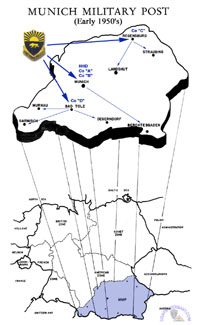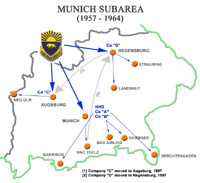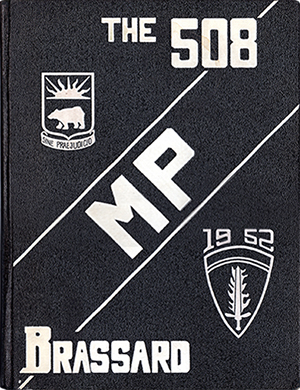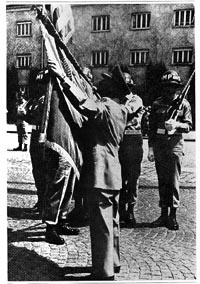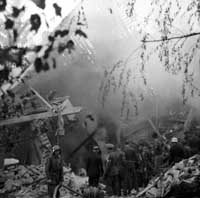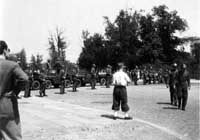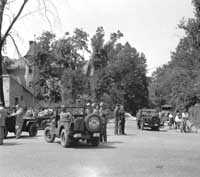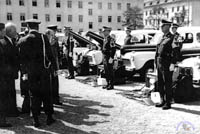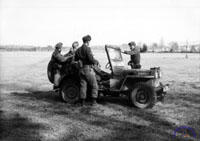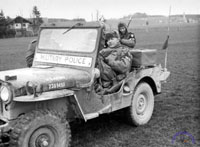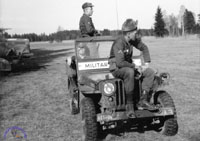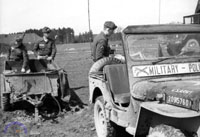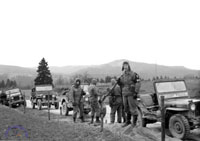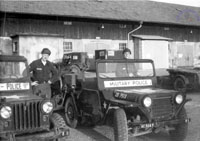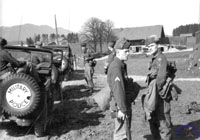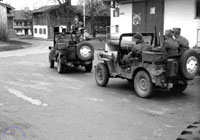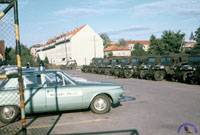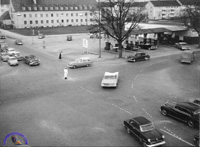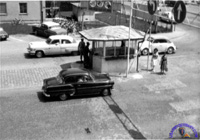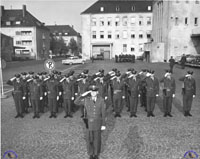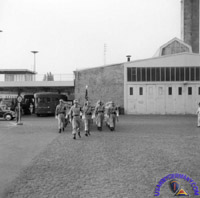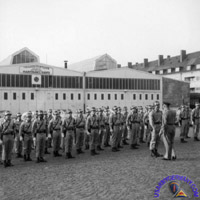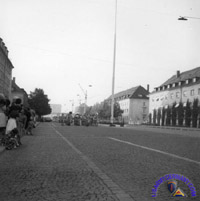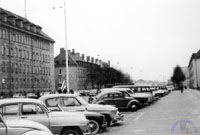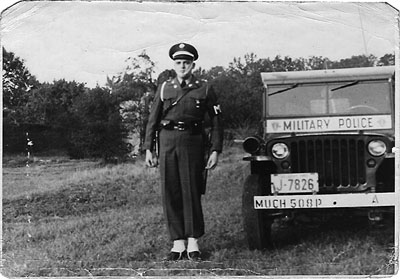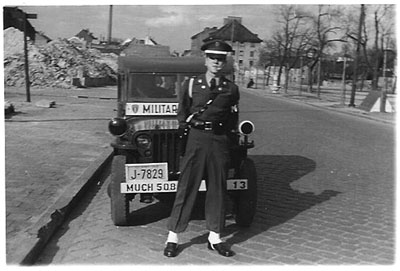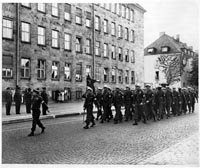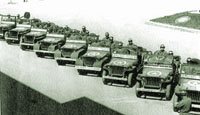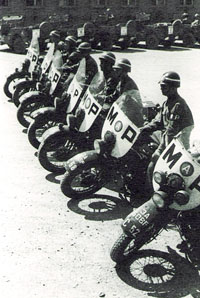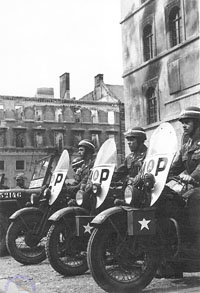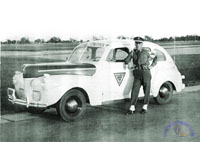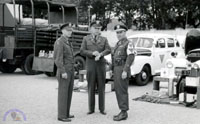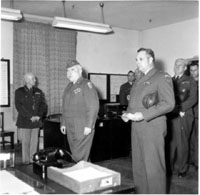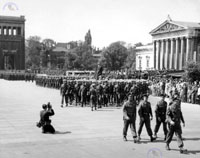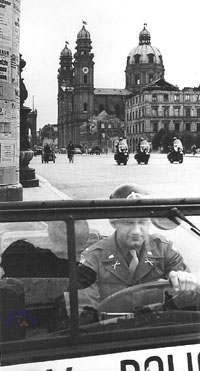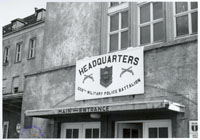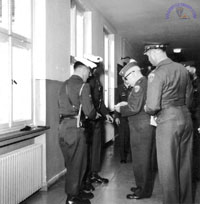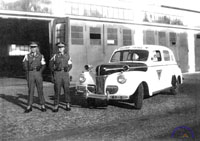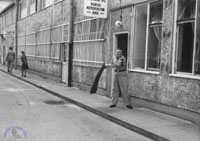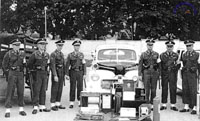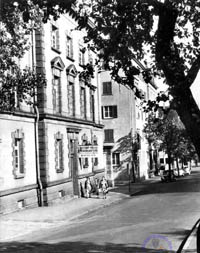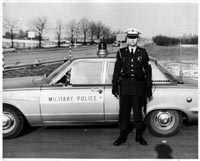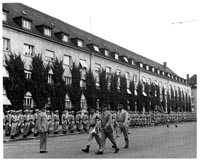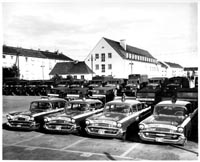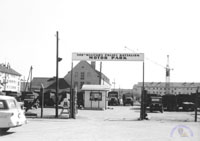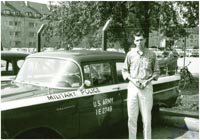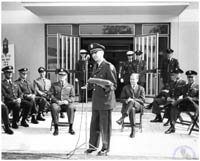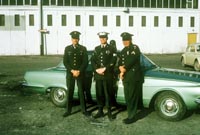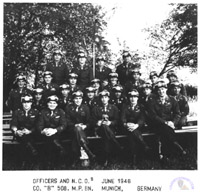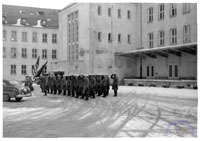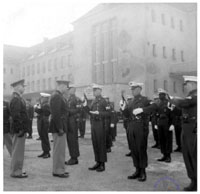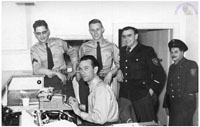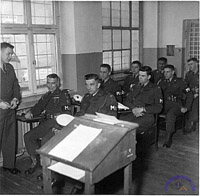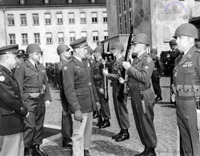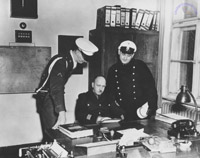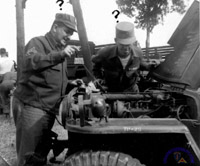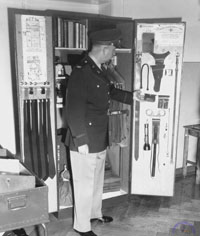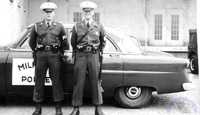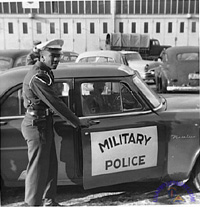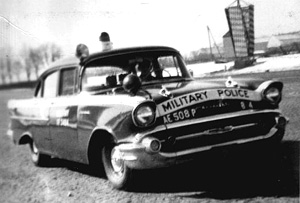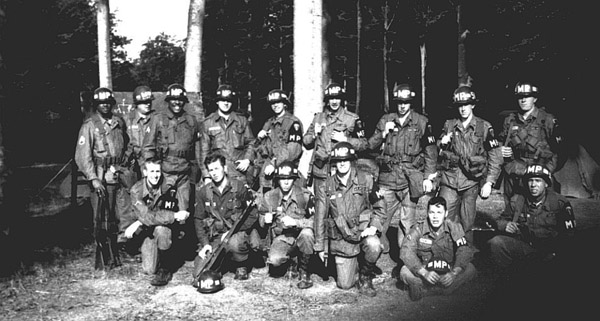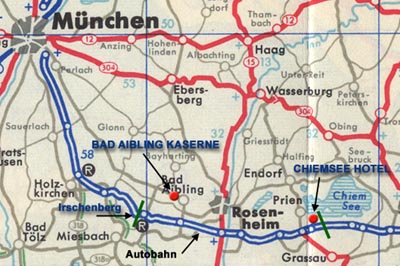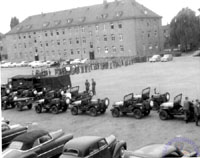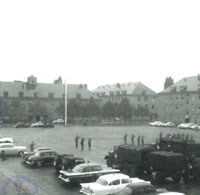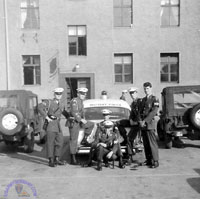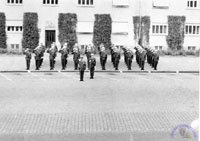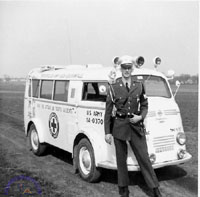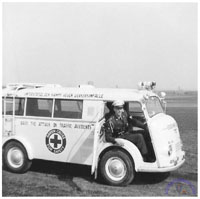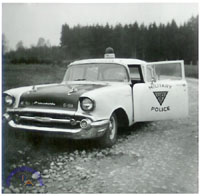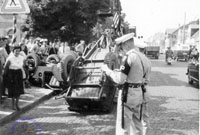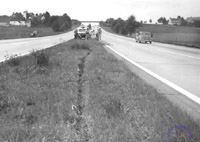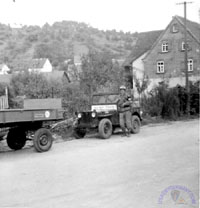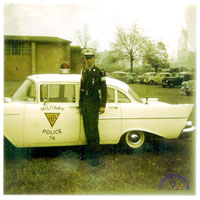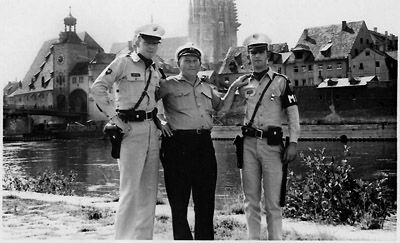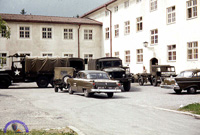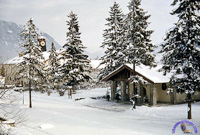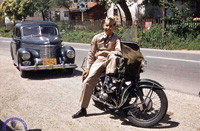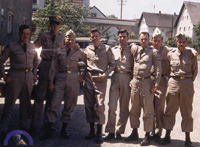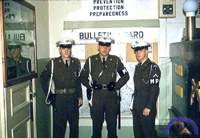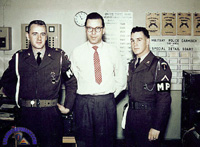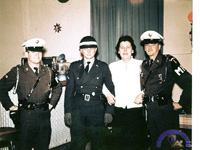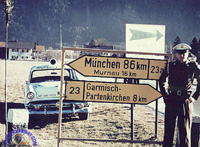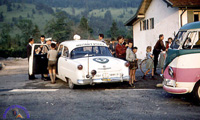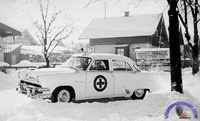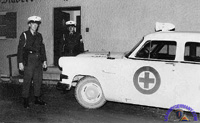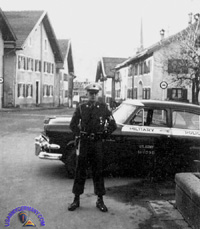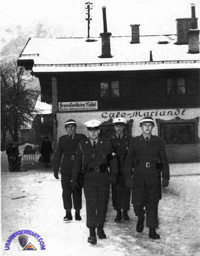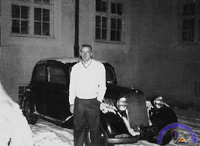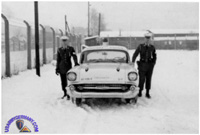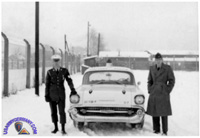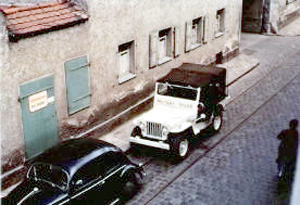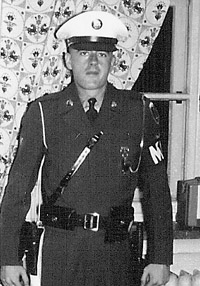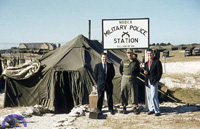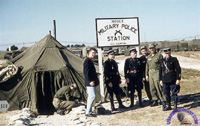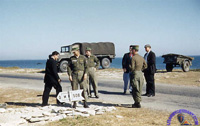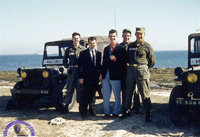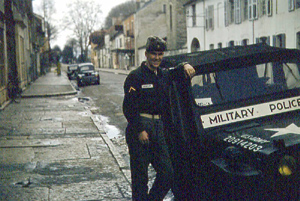| If you do
NOT see the Table of Contents frame to the left of this page, then
Click here to open 'USArmyGermany' frameset |
||||||||||||||||||||||||||||||
|
508th
Military Police Battalion |
||||||||||||||||||||||||||||||
|
|
||||||||||||||||||||||||||||||
|
||||||||||||||||||||||||||||||
|
|
||||||||||||||||||||||||||||||
| Battalion History | ||||||||||||||||||||||||||||||
| 1945 - 1964 | ||||||||||||||||||||||||||||||
| (Source: Email from Dick Burch) | ||||||||||||||||||||||||||||||
| The 508th Military Police Battalion was originally constituted on 29 July 1921 in the Organized Reserve as the 308th Military Police Battalion. This unit was allotted to the Regular Army, 1 January 1938. The 1st of June 1940, the Battalion was officially re-designated as the 508th Military Police Battalion. The 508th Military Police Battalion with Headquarters and Headquarters Detachment and Companies A, B and C, were activated 20 March 1944 at Ft Sam Houston, Texas. (The Battalion arrived in the European Theater in December 1944. It initially served in England where in January 1945, it was transferred to the newly formed 15th Army. In mid-March, the 508th was moved to France and attached to 1st Army. The battalion participated in the final drive of the allied armies into Germany performing traffic control, operation of straggler control points, and suppression of violence between Russian and Polish displaced persons and German Civilians in and around the area of Dueren, Germany. For more details, see Dick Burch's HHD, 508th MP Bn web site - link is in the Related Links section below.) Battalion Headquarters, 508th Military Police Battalion was moved on 27 April 1945 from Dueren to Frechen, Germany, APO 408 and the Companies and Detachments of the Companies were on duty throughout the Aachen-Cologne Area. On 24 June 1945, orders were received effecting the assembly and transfer of the 508th Military Police Battalion to Munich, Germany, APO 403, in the heart of Bavaria. This meant the end of attachment to the 1st US Army and assignment to the 15th US Army and a new assignment with the famous 3rd US Army with General George C. Patton as the Commanding General. The 508th Military Police Battalion arrived in Munich on 27 June 1945 with Hq and Hq Detachment and Co's A, B and C and was located in the Stetten Kaserne, Dachau Strasse. The MP Station was located at #6 Sophien Strasse, (behind the train station) downtown Munich. On the 12th of July 1945, the 508th Military Police Battalion relieved the 512th Military Police Battalion of all active duty in Munich and having been reinforced with 200 enlisted men took over the mission of law enforcement in Munich and it's environs. This was indeed a difficult assignment for an Army MP Battalion. Munich, a pre-war city of 750,000 and the age old culture center of Bavaria, had also the dubious fame of being the birthplace of the Nazi Party. In fact, the beer cellar in which Hitler first met his cohorts and which was later the scene of a bombing attempt on his life, had been adopted for use as an American Red Cross Club, the "Buergerbraeu-Keller". To facilitate and raise the efficiency of operations, the city was divided into three sectors with a company assigned to each sector. Co "A", 508th MP BN was assigned the section north of Landsberger Strasse and west of the Isar River. Co "B" 508th MP BN was assigned the opposite sector East of the river and south of Landsberger Strasse. Co "C" 508th MP BN was assigned the Area from the Hauptbahnhof (Main Railroad Station) west to the suburb of Laim. The problem of policing included control of large numbers of Displaced Persons and their camps. These people were of all nationalities from all of Europe and included the lawless elements always found in such homeless groups. Black marketeering, riots and crimes of violence aggravated by a large influx of allied troops on furlough and pass, kept the Battalion busy day and night. There were two (2) Traffic Posts operated by Company C, 508th MP BN in it's sector. One being at the eight-street intersection at Rosenheimer Platz and the other at the three-street intersection at Zweibruecken Strasse and Rosenheimer Strasse. It was the duty of Military Police on these posts to keep traffic moving properly, give correct directions to and locations of travel routes to anyone traveling through or in Munich. It was a large task at this time as the flow of traffic was continuous, with convoys of troops being shifted to new stations and being deployed. It was difficult at first to get the German civilians to obey signals as they were unfamiliar with them. However it was not long before the Germans began to understand with the help of Radio announcements and other informational programs. Several thousands bicycles and A Traffic Regulating Post (TRP) was established at Rosenheimer Strasse and Zweibrueckener Strasse. The TRP was manned by two Military Policemen and a German Interpreter. This post was equipped with large maps of Germany and locator logs for units. It became one of the critical and central information agencies in Munich. Also attached to this TRP were two-foot patrols, which covered the surrounding area directing people to the TRP and enforcing uniform regulations and other laws. In Aug 1945, the direction of traffic at intersections was turned over to American-trained Civil Police. This ended the mechanical direction of traffic by Military Police, but the TRP was kept in operation for the benefit of Americans. On St. Martins Strasse, a Maintenance Law Office was maintained which had a Desk Sergeant and the necessary interpreters and clerks. This was the Operations Office for Company C sector. Also attached was an Investigation Section which made Special Investigations in cases of serious crimes, curfew violations by civilians were handled in this office with the offenders being booked and sent to Cornelius Prison for trial. Company C, 508th MP BN also furnished a detachment known as the "Palace Guards” One notable lack in equipment that increased the difficulty of operation was radio communications. This situation was relieved in September 1945, by the installation of Police Radio Net. This net was the second of it's type to be operated on the continent by a Military Police Organization, the first having been installed in Paris. With the installation of this net completed and with the consolidation of Booking Office at MP Headquarters at 28 Ludwig Strasse, the operating efficiency increased to a point that compared favorably with any Metropolitan Police Force. By December 1945, the 508th Military Police Battalion was well settled in Munich with the main problem being the loss of trained personnel in the redeployment rush. In any event a better but less active year was looked forward to in 1946. At the beginning of 1946, the members of the 508th Military Police Battalion were to be patrons of an eventful year. The Battalion was the receipient of frequent commendations from higher headquarters and distinguished personages. By those who participated or witnessed the eventful visit of the Army Chief of Staff General Dwight D. Eisenhower reviewing the elements of the 508th Military Police Battalion and the 2nd Constabulary Brigade, a memory of that colorful moment will not be easy to forget. |
||||||||||||||||||||||||||||||
|
||||||||||||||||||||||||||||||
| In August 1963, Headquarters and Headquarters Detachment, 508th Military Police Battalion and Company's "A" and "B" relocated from McGraw Kaserne (across the road from the main gate of McGraw Kaserne) to a new Headquarters, 508th Military Police Battalion Building called Von Steuben Hall. On 21 October 1963 the new Headquarters Building was dedicated and Platoons of the 508th MP's and the 760th Battalion Feldjaegers (German MP's from the German Bundeswehr) were present for the dedication. At this time, Company "C", 508th MP BN was located at the Infantry Kaserne in Augsburg. Company "D", 508th MP BN was located in Straubing, Landshut and Regensburg. On 1 July 1964, Headquarters and Headquarters Detachment, 508th Military Police Battalion and Companies "A," "B," "C" and "D" were deactivated per USAREUR General Order No.201. During 1 June 1964 saw the formal deactivation ceremonies of the 508 Military Police Battalion. On the last day, the unit marched from Von Steuben Hall (across the road from McGraw Kaserne) and entered the gates of McGraw Kaserne proceeding up the main street to the front of Southern Area Command (SACOM) Headquarters. Battalion personnel then formed into a Battalion Formation and a brief history of the 508th MP BN was read. Colonel Lee C. Miller, SACOM Commander reviewed the troops and the colors were officially retired by Major Franklin M. Conway, Commanding Officer of the 508th and SGM Murrey E. Morris, BN SGM. Colonel Miller made a final address to the Battalion and then the 508th Military Police Battalion passed in review and marched away for the last time. Upon deactivation of the 508th MP BN in Munich, former members from Company's "A" and "B" were either assigned to Co C, 793rd MP BN, which was assigned to Von Steuben Hall, Munich to replace the 508th MP BN in Munich. Former members of the 508th MP BN not remaining in Munich were reassigned to other military police units within Germany. (The above unit history information was obtained by reviewing files of the 508th MP BN at Carlisle Barracks, Pa; information provided by the MP School Historical Office; and from information obtained from the 1947 508th MP BN Yearbook; open sources and from experiences of former members of the 508th MP BN during 1944 to 1964. The history was compiled and documented by Richard W. Burch, retired member of the Military Police Corps and former member of the 508th MP BN.) |
||||||||||||||||||||||||||||||
Of The Troops And For The Troops "SINE PRAE JUDICO" "JUSTICE WITHOUT PREJUDICE" |
||||||||||||||||||||||||||||||
|
||||||||||||||||||||||||||||||
| 1953 | ||||||||||||||||||||||||||||||
| (Source: MILITARY POLICE Journal, February 1953) | ||||||||||||||||||||||||||||||
| The "new look" sported by the 508th MP Battalion in Metropolitan Munich is being hailed as one of the most notable advances in the policing of the largest city in the US Zone of Germany since the Bn assumed the task shortly after the close of WWIl in 1946. Few shed tears when the old familiar white top jeeps were finally shunted aside in favor of the 20 new 1952 Chevrolet sedans, least of all the German policemen who used to bounce around the rear of the jeeps when riding with MPs patrols over the bumpy cobblestone streets of Munich as part of German-American police cooperation providing for mixed patrols netting the city, capable of handling any German or American incident. But comfort was not the sole objective of the Battalion's innovation. Other, and more important, advantages have been cited, such as economy and safety. The sedans saved the government money the day they were installed because their purchase price is substantially lower than that of jeeps whose four-wheel and low-range drive can hardly be used in the city. Subsequent experience has shown that the sedans use less gas than the old jeeps and the fewer repairs needed because of the lessening of accidents save the tax-payer money. The new vehicles are safer because of the greatly increased field of vision, ease of driving, right and left turn indicators, and more room for the occupants. Freedom of movement enables the policemen to enter and leave the vehicle more easily and promotes greater security in the guarding of prisoners. The new sedans are well-equipped for just about any weather and emergency. Radios provide for quick dispatch of the patrol car to the scene of an incident. Defrosters and heaters make winter driving safer and more comfortable. Emergency equipment includes a siren, flashing blue light, first-aid kit, blanket, tool kit, tow rope, warning kit composed of flares, flashlights, battery-operated baton, and roadside reflectors, and an operations kit consisting of special instructions, city maps, and a list of wanted persons, AWOLs, and stolen vehicles. The white-marked OD sedans are used solely for partol. Although they have been displaced, the jeeps have not lost their usefulness. While up to eight sedans are on patrol during each eight-hour patrol with two military and one German policemen in each, the jeeps are used for other battalion functions. Special military police details, battalion alert exercises, field problems, and everyday incidental details keeps the jeeps busy and in much demand. But it is in the present primary duty of the Battalion of policing Munich and cementing German-American relations through close police work that the new vehicles are proving their worth. |
||||||||||||||||||||||||||||||
| 1959 | ||||||||||||||||||||||||||||||
| (Source: Email from Finley Duke (SP4)) | ||||||||||||||||||||||||||||||
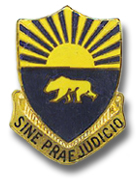 508th Military Police Battalion DI
508th Military Police Battalion DII noticed that you didn't have anything about the 508 MP Battalion. Maybe the following can be used. In 1943, Col. Elmer L. Lentz was sent to Fort Sam Houston, Texas to activate and command the 508th Military Police Battalion and deployed with them to England in December of 1943. His unit supported the First US Army throughout Europe during the war with emphasis on prisoner of war operations. The 508th had occupation duty in Munich, Germany in support of the Third US Army until 1946. I arrived in Augsburg in late December 1959. I was picked up at the train station by the First Sgt. in a 1957 Chevrolet sedan. The other solders that I had traveled with were loaded into big trucks. They were still there (in the cold) as we drove away in the warm sedan to my new home at 'Infantry' Kaserne. I was nineteen years old, and now a part of CO. 'C' 508th Military Police Battalion. Captain Krebbs was CO. I was a Pvt. (E-2). One end of our barracks was bombed in WW2 and never repaired. It was still that way when I left. When I rotated, Lt. Bell had just been promoted to Captain and CO, replacing Capt. Shannon (Capt. Krebbs' replacement). I soon learned that CO 'A' and 'B' were in Munich, CO 'D' was in Regensburg. Our unit policed all military personnel and their dependents, as well as American civilian personnel employed my the military including school teachers, civil servants etc. We had four town patrol units and two traffic units for traffic accidents involving American military personnel. One unit in the city, the other a Highway patrol unit assigned to the autobahn and outlying areas. The Hwy. Patrol unit performed the same duty as the old 62nd Highway patrol unit from a few years past. The town patrol units operated in the same manner as any 'back home' police Dept. in keeping the peace among the troops who were on duty, or off. We ran three shifts, 24 hours a day including a shift supervisor, desk Sergeant and a jail. We were just kids, but it didn't take long to get old. The Berlin wall going up caused me to be extended six months past my expected rotation date. I left in the summer of 1962. Except for Basic training at Fort Ord and MP school at Fort Gordon my active duty was in Augsburg. I went to Germany on a ship called the 'Patch,' I returned to the States on a ship called the 'Rose.' My duty with the 508th MP Battalion was an unforgettable experience. I don't know when the 508th left Germany, but; On, 2 April 1973, the 508th Military Police Battalion at Fort Riley Kansas was redesignated as the 716th Military Police Battalion. (Webmaster Note: According to the Army Lineage Series "Military Police," the 508th was inactivated in Germany on 1 July 1964. The Bn was reactivated at Fort Riley, KS on 25 August 1967 and remained on active duty until 29 March 1973 when it was again inactivated.) |
||||||||||||||||||||||||||||||
| (Source: Southern Area Command newspaper article from July 1964 submitted by Richard Burch) | ||||||||||||||||||||||||||||||
| 508th MPs Deactivate In Munich Monday, 1 June (1964), saw the formal deactivation ceremonies of the 508th Military Police Battalion in front of Headquarters, Southern Area Command, McGraw Kaserne in Munich, Germany. The entire battalion, including detachments from Straubing, Augsburg and other outlying installations, passed in review and witnessed the formal retirement of the battalion colors. |
||||||||||||||||||||||||||||||
|
||||||||||||||||||||||||||||||
| After the ceremonies the members of the battalion held a picnic at Perlacher Forst. Steaks, beer, and music by the Western Gentlemen called a close to an exciting day of ceremony and festivities: the battalion birthday and its formal retirement. | ||||||||||||||||||||||||||||||
| If you have more
information on the history or organization of the 508th MP Bn, please
contact me |
||||||||||||||||||||||||||||||
|
||||||||||||||||||||||||||||||
|
|
||||||||||||||||||||||||||||||
| Headquarters & Headquarters Detachment, 508th MP Bn | ||||||||||||||||||||||||||||||
|
||||||||||||||||||||||||||||||
| Company "A," 508th MP Bn | ||||||||||||||||||||||||||||||
| (Source: Email from James W. Jackson, "A" Company, 508th MP Svc Bn, 1949-52) | ||||||||||||||||||||||||||||||
| I was a member
of Company "A", 508th MP Bn from Dec 1949 until Aug 1952, in Munich,
Germany. When I joined the 508th we were stationed in the Stettin
Kaserne on Dachau Strasse in Munich. We were later stationed at the
McGraw Kaserne in Munich. I later joined the United Stares Air Force
and retired in 1974, spending all my time in the Air Force Air Police
and Security Police. I will never forget this experience. Jim Jackson |
||||||||||||||||||||||||||||||
|
|
||||||||||||||||||||||||||||||
| (Source: Email from Albert N Levison, 508th MP Svc Bn, early 1950s) | ||||||||||||||||||||||||||||||
| When I joined
Co A in Jan 1950 after serving in the Constabulary, there were Companies
A and B, both operating in Munich. The Isar River was the dividing
line, and the two companies switched parts of the town each month.
Highway Patrol was formed, and in the summer of 1951, Company C was
formed to serve outlying towns. I served for a short time in the 3rd Platoon of Company C in Landshut before rotating to the States and on to KOREA. Albert N Levison, MSG, US Army Retired |
||||||||||||||||||||||||||||||
|
||||||||||||||||||||||||||||||
| (Source: Email from Wayne Fitzpatrick, "A" Company, 508th MP Bn, 1962-63) | ||||||||||||||||||||||||||||||
| OF THE TROOPS AND FOR THE TROOPS, . I was once a member of Co A, 508th Military Police Bn, Munich, Germany. I was initially stationed at McGraw Kaserne and later at Berchtesgaden for the balance of my stay. I pitched softball for the battalion, in 1962, and we won the SACom Championship against HQ, SACom. I loved my stay in Germany and being an MP. (SACom - Southern Area Command, Munich) I had Basic at Ft. Gordon in late 1961, went over on the USNS Patch and returned on the USNS Gordon. After my active duty I served in a Signal unit in Denver and later as an NCOIC of an NCO Academy. |
||||||||||||||||||||||||||||||
| (Source: Email from Richard Burch, Co A, 508th MP Bn) | ||||||||||||||||||||||||||||||
|
||||||||||||||||||||||||||||||
|
||||||||||||||||||||||||||||||
|
||||||||||||||||||||||||||||||
| Company "B," 508th MP Bn | ||||||||||||||||||||||||||||||
| 1946 | ||||||||||||||||||||||||||||||
| (Source: Bob Kruger via Dick Burch) | ||||||||||||||||||||||||||||||
|
||||||||||||||||||||||||||||||
| 1953 | ||||||||||||||||||||||||||||||
| (Source: Email from Jim Rodgers, "B" Company, 508th MP Bn, 1953-55) | ||||||||||||||||||||||||||||||
| I had just turned
19 when drafted in March 1953, took basic and MP training at Gordon,
shipped out to Germany in late July (can't remember the name of the
ship but have a friend who served on the Rose as a very young
MD much later), the Korean war ended while I was in-transit. Served with Co. B from August 1953 till February 1955 when I came home. Co's A, B and Hqtrs were all in the same building in the McGraw Kaserne on the outskirts of Munich. I remember being impressed with our quarters, wide halls with real tile floors and our rooms all had hardwood floors, the Germans built things to last. Our duties were policing the military personnel and civilian dependents. There were a large number of troops in the Munich area at that time. Our outfit consisted of the young draftees and "grizzled" veterans, most of whom had served in Korea, and many in World War II as well. I have never had any regrets, a couple of years to mature and see some of the world and meet some interesting people. Went to college on the GI Bill when I got out, and ended up with a pretty good career. Who knows how my life would have turned out otherwise. Jim Rodgers |
||||||||||||||||||||||||||||||
| 1954 | ||||||||||||||||||||||||||||||
| (Source: Email from Ron Straube, B Co, 508th MP Bn, 1954-55) | ||||||||||||||||||||||||||||||
I am sending you several pictures of my service in the 508th at McGraw Kaserne from 1954-1955. I was attached to Company B and then for a period of time on TDY to the Provost Marshall Office working at the MP Station at Sophien Strasse, Munich, as Desk Clerk.
The first picture is the MP Station crew consisting of Fred McQueen (seated), myself, Ron Straube, behind him, to my right, the radio operator, and to my left our interpreter and a German police officer. In looking over the pictures you have on your site, this may be the only picture of a MP station crew. I hope you can use it. |
||||||||||||||||||||||||||||||
|
||||||||||||||||||||||||||||||
| 1955 | ||||||||||||||||||||||||||||||
| (Source: STARS & STRIPES, March 4, 1955) | ||||||||||||||||||||||||||||||
| Munich MP Station, Sophien Strasse #6 |
||||||||||||||||||||||||||||||
|
||||||||||||||||||||||||||||||
| German police also cooperate with the MPs on patrol. A two-man AWOL apprehension team checks trouble areas, the Bahnhof, bars and hotels and asks military personnel for proper ID. CRIMINAL INVESTIGATION SECTION -- also known as MPCID, this group is responsible for apprehending personnel who have committed felonies and crimes of violence or other criminal offenses. They investigate murders, rapes, assaults, larcenies and black-marketing activities. Working in two-man teams, one investigator works at the station while the other is at home on call. A German detective works with the section to assist in cases that also involve German nationals. The station also has a German interpreter. |
||||||||||||||||||||||||||||||
|
||||||||||||||||||||||||||||||
| (Source: Email from Alan "Al" Kober) | ||||||||||||||||||||||||||||||
| I was stationed at McGraw Kaserne from March 1955 until I was transferred to Berchtesgaden in Spring of 1956. Remained there until discharged in August 1957. I did 18 months in Munich and 13 in B’gaden. The 508th has an Alumni Association. They have an annual meeting but I have never been. I would like to hear from anyone I served with. |
||||||||||||||||||||||||||||||
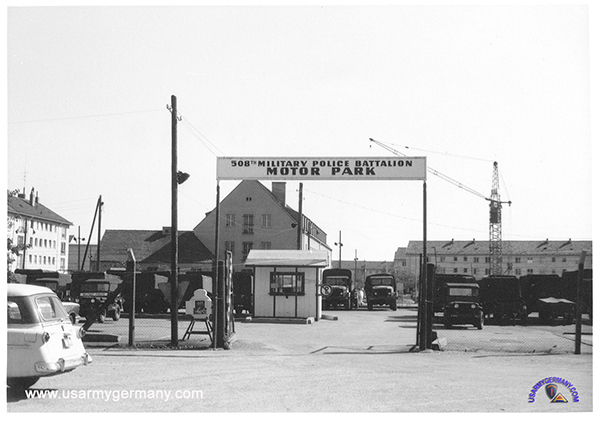 508th MP Bn motor park, McGraw Kaserne (Dick Burch) |
||||||||||||||||||||||||||||||
| Munich MCGRAW KASERNE -- At McGraw Kaserne, our billet was a German hospital and we could see the front gate. My best friend was Johnny Wallace. He was a snuff user and he would lean out the window and spit on the sidewalk which was outside the Kaserne, so much that he had a large stain on the concrete. Our building was on the left as you came through the gate, to the right was the girls dormitory from U Maryland. Further down on the left was SACOM HQ. The colonel who was the CO of the 508th was friendly with the colonel at Dachau who had a daughter at U of M. Occasionally someone would have to draw a sedan, pick up a WAC from the 26 PBO and drive the daughter back to Dachau. The girls (at the dorm) complained because our motor park was behind their dorm and when we changed shifts it was noisy, same as when we had an alert and left in the middle of the night. The mess hall was to the right and further back from the road that ran down the center of the Kaserne. The EM club was above the mess hall. There was very large garage in that area that was used for honor guards when it was raining or snowing. The movie theater was to the left as you came out of our billet. The snack bar was straight and to the left after the motor pool garage and before the snack bar. Perlacher Forest housing area was straight out the gate and probably ¼ mile down the street. Sorry I could not be of more help. |
||||||||||||||||||||||||||||||
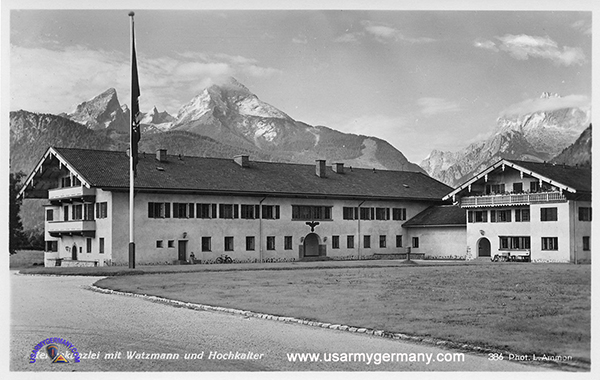 A pre-WWII era photo of the former Reichskanzlei that would become headquarters for Berchtesgaden Sub Post after the end of WWII. |
||||||||||||||||||||||||||||||
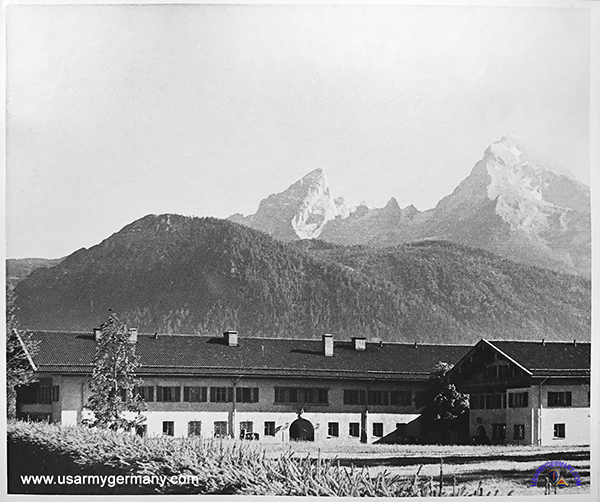 Berchtesgaden Sub Post headquarters building (Webmaster's collection) |
||||||||||||||||||||||||||||||
| Berchtesgaden STRUB KASERNE -- I don’t remember the name of the Kaserne in B’gaden but I believe we were in the Strub Kaserne. I do remember that there was a German Labor service company also in the (Strub) Kaserne. Their club was above our mess hall and it was open when we finished the night shift so we had a couple of beers up there. The manager was a husband and wife, she liked me well enough to bake me a cake when I left. There was also Air Force personnel on the same floor as we were billeted. There were 4 to a room and we had an extra wall locker filled with things. The 62nd Highway Patrol would call the desk on the phone when they saw a sedan with our bumper markings and we would push the locker in to the AF room. STANGGASS KASERNE -- The picture of the building with the Nazi symbol over the door (Stangass Kaserne) was where the MP Station was, finance was in the basement and the commanding Colonel of the area lived on the 2nd floor. Speaking of the colonel his daughter married while I was there. As I recall her husband ran the hotel in the center of B’gaden, the Deutches House. The colonel had the MP’s supplement the local police in directing traffic to the church and reception at the hotel. We were all paid by the colonel, $10 I think. Later that night as shifts were changing 2 or 3 of the bridesmaids came down the inside stairs to the desk area with cake and Champaign. They stayed for a few minutes chatting with us. Nice. I got to go to B’gaden because our 1st Sgt. Earl Dixon, combat infantry in WW11 and Korea was from Rome, Ga. And my best friend Johnny Wallace was from Rome, Ga. And he asked Johnny who he wanted to go with him. Earl Dixon wanted to get back to the infantry and was successful. He wanted out of the MP’s. Nice to see the pictures. There were 8 enlisted plus a Sgt in charge. Interesting 7 of us were RA one was a draftee. He married a local girl and stayed in. I heard many years ago from him, he did a tour in VietNam and his commanding officer was the one we had in Munich at the time he was in Munich. He was Lt. Daniel R. Holt now retired as Lt. Col. |
||||||||||||||||||||||||||||||
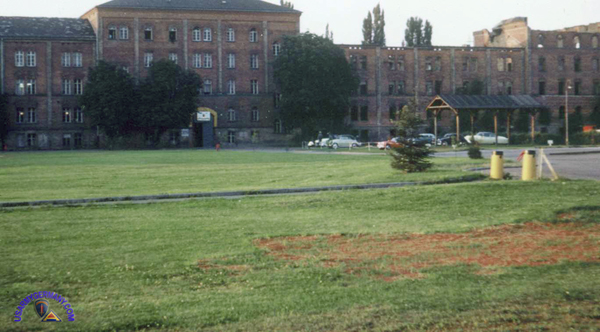 "C" Company Headquarters building, Infantry Kaserne, c. 1960 (Byrle Wentz) |
||||||||||||||||||||||||||||||
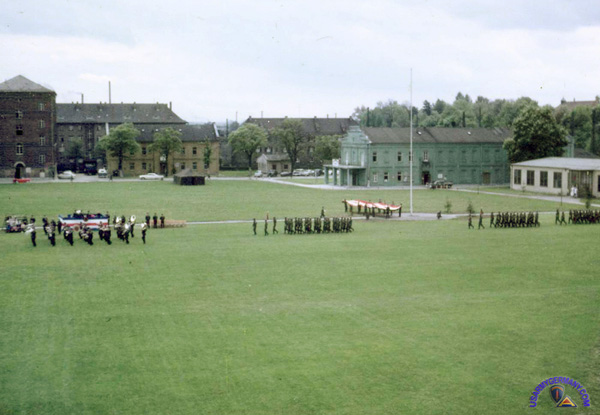 Flag Day, Infantry Kaserne, c. 1960 (Byrle Wentz) |
||||||||||||||||||||||||||||||
| 1961 | ||||||||||||||||||||||||||||||
| (Source: Email from Fred Ettinger, B Co, 508th MP Bn, 1961-63) | ||||||||||||||||||||||||||||||
|
||||||||||||||||||||||||||||||
| We were all put on alert during the Cuban Missile Crisis. And during these alerts my duty was to escort the 280-mm Atomic Cannon. While stationed at McGraw Kaserne we held an honor parade for General Clark's retirement. He had to order our supply sergeant to wear his full and complete uniform (all his medals). As it turned, he was the most decorated man in Europe, and the low ranking men never knew it till then !!!!!!!!!!! Back then we traveled to Europe and back on a troopship. I was on the USNS ROSE going over. |
||||||||||||||||||||||||||||||
|
||||||||||||||||||||||||||||||
| 1962 | ||||||||||||||||||||||||||||||
| (Source: Email from Mike Brennan, Bad Aibling Det, 1962-63) | ||||||||||||||||||||||||||||||
|
||||||||||||||||||||||||||||||
| Company "C," 508th MP Bn | ||||||||||||||||||||||||||||||
| (Source: Email from Edward C. Heitz, C Co, 508th MP Bn, 1956-59) | ||||||||||||||||||||||||||||||
I was assigned to Company C, 508th MP Bn from Aug 1956 until Aug 1959 from an assignment at Fort Benjamin Harrison, Indiana. Previous to that 3-year assignment, I was with the 793rd MP Bn at Nurnberg, Germany for 7 1/2 years, joining Company B there in June 1946.
My wife and family accompanied me to Augsburg aboard the USS General Alexander M Patch. At Augsburg, we lived in the US Army Housing area in a three story apartment building with 4 bedrooms, one for each of our children and a master bedroom.
Initially, I was assigned to Patrol Duty in the city of Augsburg, but soon was placed on duty as Desk Sgt and eventually was assigned as 1st Platoon Sergeant. Sfc Eddie Hagen, was our Operations Sgt; Sfc Rommie Howard was the 2nd Platoon Sgt; the 1st Sgt was Leslie; XO was Lt Rosen and Capt Sidella was the CO until Capt Krebs came on. During the summer of 1957, I graduated from the 7th Army NCO Academy and in 1958, I was the Company Soldier of the Month 3 times and was 508th MP BN Soldier of the Month. I formed the initial Company soltball team in 1958 and also coached it until I left in 1959. We had a great team and I hear that it went on afterwards to great success in the area. Chuck Robinson was our 1st Baseman and I'm sorry that I cannot readily recall any others. I also coached a fine team while on TDY at Bamberg for Company B 793rd in 1952. I was the catcher on all those teams. My wife, Gertrude, and our children enjoyed our assignment in Augsburg very much. It was a great experience for our three children, who have given us six wonderful grandchildren and now three great grandchildren. We still support our troops and wish them the best in their Peace Missions through out the World. From Augsburg, I returned to Fort Knox for three years and then finished out my 20 years career as Nuclear Security NCO with the 69th Ordnance Co at Vicenza Italy where I wrote the original Army Manual on Military Police Nuclear Security. I would greatly enjoy hearing from any of the old troops and also any of those now servicing. Ed Heitz
|
||||||||||||||||||||||||||||||
| (Source: Email from Chuck Bradley, "C" Company, 508th MP Bn, 1957-60) | ||||||||||||||||||||||||||||||
| I arrived in
Augsburg in Jan 57 and was assigned to Company "C" 508 MPs, housed
at Reese Kaserne. We remained at Reese until late 59 when the batallion
was moved to Infantry Kaserne. I left for stateside in Jan 60. I just returned from a trip to Europe and as a side trip went to Augsburg to see the old Kaserne. How depressing, when I was there Reese was a vibrant full of life place. Now windows are broken, the buildings are mostly deserted, wish I had never gone back. Augsburg looks great though. Built up and the downtown area looks prosperous and beautifully quaint. I didn't have a chance to see my old town patrol area, Oberhausen, but still wonder how the Kosta Bar, Blue Grotto Bar and the fancy bars like the Atlantic and Oase made out after I left. The night I left the Batallion I had the unpleasant memory of seeing one of my best friends end up in jail in our own PMO. As I remember it he had been drinking and fighting, not that unusual at the time, but I hope he made out O.K. He was one the best guys in the 508. I also wonder about Cpl. Jim Skeens, Sp3s Jackson, motor pool, Sam Richardson (sd to football team when not mping), Richard Burwell, Youngstown, Ohio There were many more but their names are now hard to recall. My regards, PFC Chuck Bradley |
||||||||||||||||||||||||||||||
|
||||||||||||||||||||||||||||||
| Company "D," 508th MP Bn | ||||||||||||||||||||||||||||||
| (Source: Email from Patrick Garland, D Co, 508th MP Bn, 1958-61) | ||||||||||||||||||||||||||||||
|
||||||||||||||||||||||||||||||
| ADDITIONAL INFORMATION I was assigned to Co D, 508th MP Bn, Regensburg, from 1958-1961. Upon my arrival, the MP Station and billets were on Raffler Kaserne, and both of my children were born in the station hospital, also on Raffler. Memory is fading, but I guess we moved to Ft Skelly in 1959, and the resident units were the 3rd Squadron, 11th Arm'd Cav, and the 502nd Medical Company. There were probably others, but those I well remember.
An interesting story, I was on MP Duty and was sent to see the 11th's Officer of the Day. While out checking the guard posts (motor pool, I believe) he encountered a German National, wearing US Army uniform and carrying a rifle. Through my interpreter, the German had volunteered to replace a GI who had jumped the fence to consort with a fraulein. Of course, when the GI returned, he got more of a welcome than he wanted! My last visit to Regensburg was in 1973, and the entire city had changed. Thanks for all the work you do in keeping alive the story of USAREUR. |
||||||||||||||||||||||||||||||
|
||||||||||||||||||||||||||||||
|
||||||||||||||||||||||||||||||
|
||||||||||||||||||||||||||||||
|
||||||||||||||||||||||||||||||
|
Related
Links |
||||||||||||||||||||||||||||||

